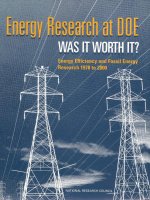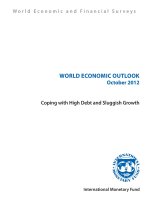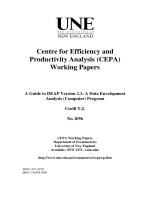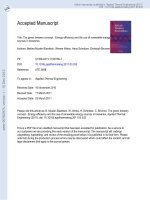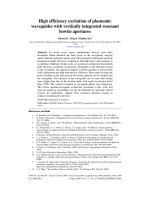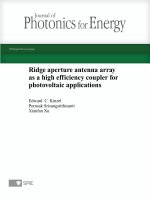High efficiency and digitally controlled AC DC converter with power factor correction and fast output voltage regulation
Bạn đang xem bản rút gọn của tài liệu. Xem và tải ngay bản đầy đủ của tài liệu tại đây (6.86 MB, 240 trang )
HIGH EFFICIENCY AND DIGITALLY
CONTROLLED AC-DC CONVERTER WITH
POWER FACTOR CORRECTION AND FAST
OUTPUT VOLTAGE REGULATION
LIM SHU FAN
(B.Eng.(Hons.), NUS)
A THESIS SUBMITTED FOR THE DEGREE OF
DOCTOR OF PHILOSOPHY
DEPARTMENT OF ELECTRICAL & COMPUTER
ENGINEERING
NATIONAL UNIVERSITY OF SINGAPORE
2012
i
Acknowledgements
I would like to express my sincere gratitude to Dr. Ashwin M Khambadkone,
my research supervisor, for his advice and patient guidance throughout the course
of my research studies. I am always amazed by how he can make a problem look so
simple, his clear grasp of engineering concepts at fundamental level, his energy and
enthusiasm while working on research problems with practical usage in mind. He
has always been a positive role model for me all these years since undergraduate
times in the National University of Singapore.
In addition, I would like to thank Mr. Woo Ying Chee and Mr. Mukaya
Chandra from the Electric Machines and Drives Laboratory for all the help in
the ordering and searching of laboratory equipments and components. They are
always ready to offer technical advice and help, and a listening ear to my problems.
I would also like to thank Mr. Abdul Jalil Bin Din for his a dvice on PCB design
and his help on PCB fabrication.
I gratefully acknowledge Infineon Technologies Asia Pacific Pte. Ltd. for the
sponsorship of my research studies in the National University of Singapo re. I would
like to express my sincere appreciation to Mr. Simon Sim of Infineon Technologies
Asia Pacific Pte. Ltd. for offering this unique opportunity to me.
During the course of studies in National University of Singapore, the experi-
ence has been made pleasant by the many friends surrounding me. With special
thanks to Ms. Zhou Haihua, Ms. Yu Xiaoxiao, Ms. Wang Huanhuan and Mr.
Tran Duong for all the encouragement and help in one way or another.
Lastly, I would not have accomplished the completion of my research studies
without the support from my family. I would like to thank my parent s, Mr. Lim
Tong Liang and Ms. Lee Beh Bee, for taking great care of me while I continued my
studies and my sister, Lim Shurong, for her encouragement and company. I would
like to thank my husband, Richard Ng, who has been by my side all the time,
suppo r t ing and encouraging me on during the difficult moments, and advising me
on digital design.
iii
Contents
Acknowledgements i
Summary vii
List of Tables x
List of Figures xi
List of Abbreviations xviii
1 Introduction 1
1.1 Problem Definition . . . . . . . . . . . . . . . . . . . . . . . . . . . 12
1.2 Contribution of the Thesis . . . . . . . . . . . . . . . . . . . . . . . 17
1.3 Organization of the Thesis . . . . . . . . . . . . . . . . . . . . . . . 20
2 Nonlinear Inductor for Improving Efficiency at Light Load in PFC 22
2.1 Meeting Increasing Efficiency Requirement for the Complete Load
Range . . . . . . . . . . . . . . . . . . . . . . . . . . . . . . . . . . 22
2.2 Causes of Poor Light Load Efficiency in PFC . . . . . . . . . . . . . 24
2.3 Nonlinear Inductor for Improving Light Load Efficiency . . . . . . . 27
2.4 Nonlinear Inductor Design for PFC . . . . . . . . . . . . . . . . . . 34
2.5 Experimental Results and Analysis . . . . . . . . . . . . . . . . . . 41
2.6 Summary . . . . . . . . . . . . . . . . . . . . . . . . . . . . . . . . 66
3 CCM-DCM Digital Control for Improving Efficiency and Power
Factor at Light Load 68
3.1 Control of PFC f or Complete Load Range . . . . . . . . . . . . . . 68
3.2 Suitable CCM PFC Control Scheme for Digital Implementation . . 70
3.2.1 Input Current Control Techniques for CCM PFC Converters 71
3.2.1.1 Average Current Control . . . . . . . . . . . . . . . 7 1
3.2.1.2 Peak Current Control . . . . . . . . . . . . . . . . 75
3.2.1.3 Hysteresis Current Control . . . . . . . . . . . . . 77
3.2.1.4 Nonlinear Carrier Control . . . . . . . . . . . . . . 78
3.2.1.5 One Cycle Control . . . . . . . . . . . . . . . . . . 80
3.2.2 Suitable CCM PFC Control Scheme for Boost PFC with Dig-
ital Implementation . . . . . . . . . . . . . . . . . . . . . . . 81
3.2.3 CCM Control Design . . . . . . . . . . . . . . . . . . . . . . 83
3.2.3.1 Modeling of Boost Converter for Average Current
Control . . . . . . . . . . . . . . . . . . . . . . . . 83
3.2.3.2 Sampling of Va r ia bles for Control . . . . . . . . . . 93
3.2.3.3 Low Pass Filter Design for Input Voltage Feedforward10 4
3.2.3.4 Multiplier Design . . . . . . . . . . . . . . . . . . . 109
3.2.3.5 Current Controller Design . . . . . . . . . . . . . . 111
3.2.3.6 Voltage Controller Design . . . . . . . . . . . . . . 116
3.2.4 Controller Implementation and Simulation Results . . . . . . 119
3.3 Suitable DCM PFC Cont r ol Scheme to be Used at Light Load with
Digital Implementation . . . . . . . . . . . . . . . . . . . . . . . . . 120
3.3.1 Problems in DCM Using CCM Current Controller . . . . . . 120
3.3.2 Inductor Current Sample Correction in DCM . . . . . . . . 123
3.3.3 DCM Control Techniques for PFC Operating in Both CCM
and DCM . . . . . . . . . . . . . . . . . . . . . . . . . . . . 125
3.3.4 The Proposed DCM Control Scheme . . . . . . . . . . . . . 12 9
3.3.5 Performance of the Proposed CCM-DCM Control Scheme . 132
3.3.6 Summary . . . . . . . . . . . . . . . . . . . . . . . . . . . . 147
4 Multimo de Digital Control for Improving Efficiency at Very Light
Load 149
4.1 Suitable Control Scheme for Very Light Load Conditions That En-
sures Minimum Power Consumption and Output Voltage Regulation 149
4.1.1 Importance of Reducing Power Consumption Under Very
Light Lo ad Conditions of PFC . . . . . . . . . . . . . . . . . 149
4.1.2 Existing Solutions for Reducing Power Consumption Under
Very Light Load Conditions of PFC . . . . . . . . . . . . . . 151
4.1.3 The Proposed Multimode Digital Control Scheme for Im-
proving efficiency and Ensuring Output Voltage Regulation
at Very Light Load . . . . . . . . . . . . . . . . . . . . . . . 159
4.1.4 Control Analysis of the Proposed Multimode Digital Control
Scheme . . . . . . . . . . . . . . . . . . . . . . . . . . . . . 162
4.1.5 Performance of the Proposed Multimode Digital Control Scheme
at Very Light Load . . . . . . . . . . . . . . . . . . . . . . . 170
4.1.6 Summary . . . . . . . . . . . . . . . . . . . . . . . . . . . . 176
4.2 Improvement of Efficiency and Power Factor at Light Load with the
Proposed Multimode Control Scheme . . . . . . . . . . . . . . . . . 178
5 Conclusion and Future Work 189
5.1 Conclusion . . . . . . . . . . . . . . . . . . . . . . . . . . . . . . . . 189
5.2 Future Work . . . . . . . . . . . . . . . . . . . . . . . . . . . . . . . 194
5.2.1 Reducing the Cost of Sensing . . . . . . . . . . . . . . . . . 196
5.2.1.1 Reducing the Number of ADCs Required . . . . . . 197
5.2.1.2 Reducing the ADC Requirements . . . . . . . . . . 200
5.2.1.3 Future Work Required in Reducing the Cost of Sens-
ing . . . . . . . . . . . . . . . . . . . . . . . . . . . 201
5.2.2 Line Frequency Independent Method to Obtain the Average
Output Voltage . . . . . . . . . . . . . . . . . . . . . . . . . 202
Bibliography 205
List of Publications 217
vii
Summary
High efficiency and power factor at light load are increasingly desired in desk-
top computer power supplies for energy saving initiative and product differentiation
with the certification o f energy saving programs. However, the efficiency and power
factor of power factor correctors (PFCs) in desktop computer power supplies are
poor at lig ht load. The constant frequency PFC controller designed for continuous
conduction mode (CCM) is unable to ensure good input current shaping in dis-
continuous conduction mode (DCM) due to nonlinear converter characteristics and
incorrect average current samples obtained if digital control is used. Poor input
current shaping in DCM causes higher current distortion and larger RMS current
drawn from the AC mains, resulting in poor efficiency and power f actor at light
load. At very light load, the load independent constant losses become dominant
and cause a steep fall in efficiency.
A nonlinear inductor that has a higher inductance at low average inductor
current a nd under light load conditions is proposed to improve light load efficiency
of PFC by reducing the constant losses contributed by inductors in the system.
Efficiency of a 300W CCM boost PFC is improved at 0.02p.u. (per unit) load
with rated load as base by 4.22% and 3.42% under an input voltage of 85VAC and
265VAC respectively. The nonlinear inductor achieves efficiency improvement at
light load without additional external components or complex control as compared
to other efficiency improvement efforts. It is a simple idea that does not require
any advance tool for its design and is applicable to any topology o r system with
inductors.
A CCM-DCM dig ital contro l scheme that improves power factor and efficiency
at light load by ensuring good input current shaping in both CCM and DCM
is propo sed for boost PFC. At a light load of 0.1p.u. and an input voltage of
230VAC, the total harmonic distortion of the input current is significantly reduced
by 87.85%, the power factor is improved from 0 .6 3 to 0.77, and the efficiency is
increased by 1.1 % for a 300W boost PFC. The proposed CCM-DCM digital control
scheme is mathematically and computationally simple. The result of all arithmetic
operations in the current control loop is achievable in one clock cycle, whereas other
DCM control schemes require multiple clock cycles. There is a smooth transition
between CCM and DCM operations of the boost converter in each AC half cycle
and between heavy and light loads with the propo sed CCM-DCM digital control
scheme.
Since constant losses are frequency dependent, they can be reduced as a
whole by reducing switching in the PFC. A multimode digital control scheme that
improves efficiency and ensures output voltage regulation at very light load in
PFC is proposed. The proposed multimode digital control scheme consists of the
proposed CCM-DCM digital control scheme a nd a no load digital control scheme.
The proposed no load digital control scheme t hat is based on on-off cont rol of the
PFC is primarily responsible for reducing constant losses with reduced switching
in the PFC a nd for ensuring output voltage regulation at very light load. It can be
added easily to the CCM-DCM digital control scheme without additional and costly
external components. Compared to other on- off control schemes, a small load jump
is sufficient to exit the no load control scheme, and this a llows a smooth transition
between the no loa d control and the CCM-DCM active mode control. Efficiency of
a 300W boost PFC is improved at 0.007p.u. load by 11.53% and 2.19% with the
proposed multimode digital control scheme under a n input voltage of 100VAC and
230VAC respectively. The multimode digital control scheme provides a simpler and
less costly solution for improving efficiency at very light load as compared to other
constant loss reduction techniques.
With the nonlinear inductor and the multimode digital control scheme, the
efficiency of PFC in a typical desktop computer power supply is improved at light
load and down to near zero load conditions. Power factor at light load is improved
and pushed above the light load power factor requirements of the energy saving
programs. The higher efficiency and power factor at lig ht load in PFC provide
a higher margin for desktop computer power supplies in meeting the increasing
efficiency and power factor requirements that are imposed by the energy saving
programs.
x
List of Tables
1.1 Efficiency Requirements of External Power Supplies under California
Energy Commission Appliance Efficiency Regulations . . . . . . . . 4
1.2 ENERGY STAR Version 4.0 Program Requirements for Computers 10
1.3 ENERGY STAR Version 5.0 Program Requirements for Computers 11
2.1 Constant loss Components . . . . . . . . . . . . . . . . . . . . . . . 27
2.2 NL
1
Core Dimensions and Design Parameters . . . . . . . . . . . . 46
2.3 Total harmonic distortion of the input current . . . . . . . . . . . . 64
2.4 Cost comparison between constant inductor and nonlinear inductor 65
3.1 Experimental measurements at an input voltage of 230VAC . . . . . 142
4.1 Gate count estimation . . . . . . . . . . . . . . . . . . . . . . . . . 173
4.2 Power consumption of boost PFC at no load . . . . . . . . . . . . . 176
xi
List of Figures
1.1 Predicted Residential Energy Usage for Household Appliances . . . 5
1.2 80 PLUS Efficiency Specifications . . . . . . . . . . . . . . . . . . . 8
1.3 80 PLUS Power Factor Specifications . . . . . . . . . . . . . . . . . 8
1.4 Typical Annual Energy Consumption of a ENERGY STAR Version
4.0 Compliant Desktop Computer . . . . . . . . . . . . . . . . . . . 10
1.5 General Efficiency Trend of Typical Power Supplies . . . . . . . . . 13
1.6 General Efficiency Trend of CCM PFCs . . . . . . . . . . . . . . . . 13
1.7 General Power Factor Trend of CCM PFCs . . . . . . . . . . . . . . 13
1.8 Annual Energy Consumption and Consumption pattern of a EN-
ERGY STAR Version 4.0 Compliant Desktop Computer . . . . . . 15
1.9 Losses in a general PFC system with Losses (p.u.) =
Losses (W)
Rated Power (W)
. 1 6
2.1 Boost PFC for loss analysis . . . . . . . . . . . . . . . . . . . . . . 25
2.2 Loss compo nents in a generic boo st PFC . . . . . . . . . . . . . . . 26
2.3 Efficiency at universal line and load conditions . . . . . . . . . . . . 26
2.4 B-H hysteresis loop . . . . . . . . . . . . . . . . . . . . . . . . . . . 28
2.5 Inductor current waveform . . . . . . . . . . . . . . . . . . . . . . . 29
2.6 Approximation of the area enclosed by the minor B-H loop . . . . . 30
2.7 The variation o f inductance with average inductor current in a non-
linear inductor . . . . . . . . . . . . . . . . . . . . . . . . . . . . . . 33
2.8 Nonlinear inductance profiles with increasing inductance under de-
creasing average inductor current . . . . . . . . . . . . . . . . . . . 35
2.9 B-H loop characteristic of the chosen powdered metal core . . . . . 37
2.10 Flow chart of the nonlinear inductor design steps . . . . . . . . . . 42
2.11 Efficiency improvement at light load with higher L
ll
. . . . . . . . . 47
2.12 Experimental setup . . . . . . . . . . . . . . . . . . . . . . . . . . . 47
2.13 Inductance of the nonlinear inductors . . . . . . . . . . . . . . . . . 48
2.14 The actual inductor current . . . . . . . . . . . . . . . . . . . . . . 49
2.15 Equivalent circuit of the boost PFC when the MOSFET turns on . 49
2.16 The worst case in inductance measurement . . . . . . . . . . . . . . 53
2.17 Efficiency of boost PFC at input voltage of 85VAC . . . . . . . . . 56
2.18 Power Factor of boost PFC at input voltage of 85VAC . . . . . . . 56
2.19 Efficiency of boost PFC at input voltage of 265VAC . . . . . . . . . 57
2.20 Power Factor of boost PFC at input voltage of 265VAC . . . . . . . 57
2.21 Inductor current ripple at 0.02p.u. load and input voltage of 265VAC 58
2.22 The inner current control loop of the ICE2PCS02 CCM PFC controller 59
2.23 Bode plot of the current control loo p at 0.02p.u. load under an
input voltage of 85VAC using a constant inductance and a nonlinear
inductance . . . . . . . . . . . . . . . . . . . . . . . . . . . . . . . . 60
2.24 Bode plot of the current control loo p at 0.02p.u. load under an
input voltage of 265VAC using a constant inductance and a no nlinear
inductance . . . . . . . . . . . . . . . . . . . . . . . . . . . . . . . . 61
2.25 Plot of gain crossover frequency with respect to input current a t full
load under an input voltage of 8 5VAC using a constant inductance
and a nonlinear inductance . . . . . . . . . . . . . . . . . . . . . . . 62
2.26 Plot of phase margin with respect to input current at full lo ad un-
der an input voltage of 85VAC using a constant inductance and a
nonlinear inductance . . . . . . . . . . . . . . . . . . . . . . . . . . 62
3.1 An ideal rectifier . . . . . . . . . . . . . . . . . . . . . . . . . . . . 71
3.2 Average current control with input voltage feedforward . . . . . . . 72
3.3 Current waveforms under average current control . . . . . . . . . . 72
3.4 Current waveforms under hysteresis current control with a variable
hysteresis band . . . . . . . . . . . . . . . . . . . . . . . . . . . . . 77
3.5 Nonlinear carrier control of boost PFC . . . . . . . . . . . . . . . . 79
3.6 Current waveforms under nonlinear carrier control . . . . . . . . . . 79
3.7 Boost PFC Specifications and Pa r ameters . . . . . . . . . . . . . . 84
3.8 Digital CCM average current control with input voltage feedforward 84
3.9 Inner current control loop in CCM . . . . . . . . . . . . . . . . . . 86
3.10 Loss free resistor model . . . . . . . . . . . . . . . . . . . . . . . . . 87
3.11 Power and output voltage waveforms of a rectifier . . . . . . . . . . 87
3.12 Equivalent circuit at the DC output . . . . . . . . . . . . . . . . . . 88
3.13 Small-signal equivalent circuit for outer voltage control loo p . . . . 91
3.14 Sampling of the average inductor current . . . . . . . . . . . . . . . 94
3.15 The error in the average inductor current obtained by sampling . . 94
3.16 Sampling of average output voltage . . . . . . . . . . . . . . . . . . 98
3.17 Sampling of average output voltage under dynamic conditions . . . 99
3.18 Power transfer at output under the a ssumption of no loss in the system101
3.19 Block diagram of a two stage low pass filter with two cascaded poles 105
3.20 Single pole filter characteristics . . . . . . . . . . . . . . . . . . . . 107
3.21 Frequency response of the two stage digita l low pass filter G
fd
(z) =
G
fd1
(z) × G
fd2
(z) and each filter stage, G
fd1
(z) and G
fd2
(z) . . . . 108
3.22 Effect of quantization of filter coefficients . . . . . . . . . . . . . . . 109
3.23 Interaction between resolution of control variables . . . . . . . . . . 111
3.24 Symmetrical PWM . . . . . . . . . . . . . . . . . . . . . . . . . . . 112
3.25 Block diagram of the inner current control loop . . . . . . . . . . . 112
3.26 Frequency response of the compensated inner current control loop . 114
3.27 Effect of quantization of coefficients in current controller . . . . . . 115
3.28 Block diagram of the outer voltage control loop . . . . . . . . . . . 116
3.29 Frequency response of the compensated outer volta ge control loop . 118
3.30 Effect of quantization of coefficients in voltage controller . . . . . . 119
3.31 Simulation results at 230VAC and full load . . . . . . . . . . . . . . 120
3.32 Simulation results at 230VAC and 0.4p.u. load . . . . . . . . . . . . 121
3.33 Simulation results at 230VAC and 0.1p.u. load . . . . . . . . . . . . 121
3.34 Inductor voltage and current in DCM . . . . . . . . . . . . . . . . . 124
3.35 Inner current control loop in CCM . . . . . . . . . . . . . . . . . . 131
3.36 Inner current control loop with the proposed DCM control scheme . 131
3.37 The proposed CCM-DCM digital controller . . . . . . . . . . . . . . 132
3.38 Simulation results at 230VAC and 0.4p.u. load with the proposed
CCM-DCM control scheme . . . . . . . . . . . . . . . . . . . . . . . 133
3.39 Simulation results at 230VAC and 0.1p.u. load with the proposed
CCM-DCM control scheme . . . . . . . . . . . . . . . . . . . . . . . 133
3.40 Phase shift at light load . . . . . . . . . . . . . . . . . . . . . . . . 135
3.41 Simulation results at 230VAC and 0.1p.u. load with new EMI filter 136
3.42 Simulation results at 230VAC and 0.4p.u. load with -10% offset in
(d + ∆
1
) . . . . . . . . . . . . . . . . . . . . . . . . . . . . . . . . . 137
3.43 Nonlinear inductance with respect to input current . . . . . . . . . 138
3.44 Simulation results at input voltage of 85VAC and full load with large
variation in boost inductance . . . . . . . . . . . . . . . . . . . . . 139
3.45 Simulation results at input voltage of 2 30VAC and 0.4p.u. load with
large variation in boost inductance . . . . . . . . . . . . . . . . . . 139
3.46 Experimental results at 230VAC, full load with sample correction
and with CCM-DCM control . . . . . . . . . . . . . . . . . . . . . . 140
3.47 Experimental results at 230VAC and 0.4p.u. load without sample
correction and with CCM control . . . . . . . . . . . . . . . . . . . 141
3.48 Experimental results at 230VAC and 0.4p.u. load with sample cor-
rection and with CCM-DCM contro l . . . . . . . . . . . . . . . . . 141
3.49 Experimental results at 230VAC and 0.1p.u. load without sample
correction and with CCM control . . . . . . . . . . . . . . . . . . . 141
3.50 Experimental results at 230VAC and 0.1p.u. load with sample cor-
rection and with CCM-DCM contro l . . . . . . . . . . . . . . . . . 141
3.51 Harmonic currents at an input volta ge of 230VAC and 0.4p.u. load 143
3.52 Dynamic response to a step change in load from 0.1 p.u. to 0.4p.u.
load at an input voltage of 230VAC. v
o
waveform is level shifted by
1p.u./392.5V to show the signal change clearly. . . . . . . . . . . . 144
3.53 Dynamic response to a step change in load from 0.2 p.u. to 0.7p.u.
load at an input voltage of 230VAC. v
o
waveform is level shifted by
1p.u./392.5V to show the signal change clearly. . . . . . . . . . . . 144
4.1 The proposed no load digital control scheme . . . . . . . . . . . . . 160
4.2 The multimode digital contro ller . . . . . . . . . . . . . . . . . . . . 160
4.3 The output voltage in the no load control mode . . . . . . . . . . . 163
4.4 The currents flowing in the boost PFC . . . . . . . . . . . . . . . . 164
4.5 Condition for state convergence . . . . . . . . . . . . . . . . . . . . 164
4.6 Simulation results at 0.007p.u. load under input voltages of 100VAC
and 230VAC showing the output voltage v
o
at the PFC turn-off instant165
4.7 Simulation results at 0.007p.u. load under input voltages of 100VAC
and 230VAC showing the output voltage v
o
when PFC is turned off 166
4.8 Simulation results at 0.007p.u. load under input voltages of 100VAC
and 230VAC showing the output voltage v
o
at the PFC turn-on instant168
4.9 Simulation results at 0.007p.u. load under input voltages of 100VAC
and 230VAC showing the output voltage v
o
when PFC is turned on 168
4.10 Phase portr ait of the boost PFC with the proposed multimode con-
trol at 0.007p.u. load under input volta ges of 100VAC and 230VAC 171
4.11 Experimental results a t 100VAC and 0.007p.u. load with t he pro-
posed multimode control scheme. v
o
waveform is level shifted by
1p.u./392.5V to show the signal change clearly. . . . . . . . . . . . 172
4.12 Experimental results when the PFC enters the no load control mode
under a step change in loa d from 0.07p.u. to 0.007p.u. load. v
o
waveform is level shifted by 1p.u./392.5V to show the signal change
clearly. . . . . . . . . . . . . . . . . . . . . . . . . . . . . . . . . . . 172
4.13 Experimental results when the PFC exits the no loa d control mode
under a step change in loa d from 0.007p.u. to 0.07p.u. load. v
o
waveform is level shifted by 1p.u./392.5V to show the signal change
clearly. . . . . . . . . . . . . . . . . . . . . . . . . . . . . . . . . . . 173
4.14 Efficiency of boost PFC a t very light loads under an input voltage
of 100VAC . . . . . . . . . . . . . . . . . . . . . . . . . . . . . . . . 175
4.15 Efficiency of boost PFC a t very light loads under an input voltage
of 230VAC . . . . . . . . . . . . . . . . . . . . . . . . . . . . . . . . 175
4.16 THD of the input current at 100VAC . . . . . . . . . . . . . . . . . 182
4.17 THD of the input current at 230VAC . . . . . . . . . . . . . . . . . 182
4.18 Efficiency of boost PFC at 100VAC . . . . . . . . . . . . . . . . . . 183
4.19 Power factor of boost PFC at 100VAC . . . . . . . . . . . . . . . . 183
xvii
4.20 Efficiency of boost PFC at 230VAC . . . . . . . . . . . . . . . . . . 184
4.21 Power factor of boost PFC at 230VAC . . . . . . . . . . . . . . . . 184
4.22 Experimental setup with FPGA implementation of the proposed
multimode digital control scheme . . . . . . . . . . . . . . . . . . . 185
5.1 Conflicting Design Requirements of Power Supply . . . . . . . . . . 196
xviii
List of Abbreviations
AC Alternating Current
ADC Analog to Digital Converter
AICS Active Input Current Shap er
ASIC Application-Specific Integrated Circuit
BIFRED Boost Integrated with Flyback Rectifier/Energy storage/DC-DC
CCM Continuous Conduction Mode
DC Direct Current
DCM Discontinuous Conduction Mode
EMI Electromagnetic Interference
FPGA Field Programmable Gate Array
kWh kilowatt-hour
LFR Loss Free Resistor
xix
LPF Low Pass Filter
MOSFET MetalOxideSemiconductor Field-Effect Transistor
MPP Molybdenum Permalloy Powder
PFC Power Factor Corrector
PI Proportional-Integral
p.u. per unit
PWM Pulsewidth Modulation
RMS Root-Mean-Square
SEPIC Single-Ended Primary Inductance Converter
TEC Typical Energy Consumption
THD Total Harmonic Distortion
UPS Uninterruptible Power Supply
U.S. United States
USD United States Dollar
VHDL VHSIC Hardware Description Language
VHSIC Very-High-Speed Integrated Circuits
xx
ZCS Zero Current Switching
ZVS Zero Voltage Switching
ZOH Zero-Order-Hold
1
Chapter 1
Introduction
Power supplies are devices that convert AC voltage from utilities into low
DC voltages for powering electronics in office equipment, telecommunications and
consumer electronics. These p ower supplies are required to comply with harmonic
current emission standards such as IEC61000-3-2 [1]. IEC61000-3-2 is a mandatory
standard, which defines the limits on harmonic currents that can be injected into
the public low voltage mains supply by each of the four classes of equipment. The
standard is implemented to prevent problems of overheating of cables and trans-
formers, supply voltage distortion, reduced performance and reliability of electronic
systems, and telephone interference. This drives the development of various passive
and active power factor correction techniques to contain harmonic current emission
within the limits imposed by the standard. [2]-[5]
However, it will no longer be sufficient for power supplies to comply only
with the IEC61000-3-2 standard. Energy demand is soaring globally but energy
Introduction 2
resources are depleting. The biggest consumers of electrical energy today are United
States and China, with rising demands across Asia and Europe [6]. Building new
power plants will not be sufficient to meet the future energy demand in view of
the depleting energy resources. Other than looking at renewable energy sources for
power generation, another means is to find solutions to reduce energy consumption
or use energy more efficiently.
Power supplies are mostly switch-mode power supplies with efficiencies in the
range of 6 5% to 70%. There are more than 10 billion AC/DC power supplies in
use worldwide, with over 2.5 billion power supplies in the United States alone. The
total electrical energy consumed by existing power supplies in the United States
is greater than 207 billion kWh per year. Approximately 500 million new power
supplies are sold each year. [7]
With the tremendous growth rate of demands for electronic appliances world-
wide, improving the efficiency of power supplies will be of great importance in
meeting such growth in view of increasing future energy demand and decreasing
energy resources. [7] estimates that a saving of 15% of the total electrical energy
consumed by existing power supplies in the United States (U.S.) or 3 2 billion kWh
per year can save USD$2.5 billion in energy bills and reduce carbon dioxide emis-
sions by more than 24 million tons per year. This amount of power is equivalent
to the annual power output of 7 large power plants. Thus, we need solutions to
increase the efficiency of power supplies with greater urgency than befor e. [7]-[8]
Introduction 3
Many government agencies across the world are established to promote energy
saving within their countries thro ugh education, introducing marketing incentives
and mandato ry regulations. Voluntary energy saving programs focus on educa-
tion to create public awareness and introducing marketing incentive to encourage
the participation of power supply manufacturers. These voluntary energy saving
programs began efforts by developing consumer awareness of the importance and
benefits of energy saving, leading to a demand for higher efficiency products. Prod-
uct marking with the respective agencies logo s for product differentiatio n and cash
rebates to manufacturers for each unit of higher efficiency rating products sold are
some of the marketing incentives introduced. [8]-[10]
However, there will be a limit to how far these voluntary programs can push
for efficiency improvement because there are always additional costs incurred for
improving efficiency. Thus, mandatory regulations are introduced in some countries
such that manufacturers are obliged to develop higher efficiency products. The
California Energy Commission Appliance Efficiency Regulations require all external
power supplies with power ratings below 250W that are sold in California to meet
the minimum efficiency requirement in active mode operation and the maximum
power consumption limit in no load condition by 1st July 2008. No load refers to a
condition in which the external power supply of a device is connected to the mains
AC supply but there is no device or load connected at the output of the power
supply. The regulation requirements are shown in Table 1.1 [11]. The Commission
Regulation (EC) No 278/2009 of 6 April 2009 under the European Commission
Introduction 4
has the same requirements in active mode operation and no load condition of
external power supplies as the California Energy Commission Appliance Efficiency
Regulations [12].
Table 1.1: Efficiency Requirements of External Power Supplies under California
Energy Commission Appliance Efficiency Regulations
Mode Nameplate Output Efficiency Requirements
Active Minimum Efficiency
< 1W (0.5 ×Nameplate Output) × 100%
≥ 1W and ≤ 51W (0.09Ln(Nameplate Output) + 0.5) × 100%
> 51W 85%
No load Maximum Energy Consumption
Any output 0.5W
Ln(Nameplate Output) = Natural Logarithm of the nameplate output in watts
Other mandatory regulations include t he Commission R egulation (EC) No
1275/2008 of 17 December 2008, where the maximum power consumption require-
ments for standby mode and off mode of consumer electronics and office equipment
are defined. In bo t h standby mode and off mode, the electronic device is shut off
but is still connected to the mains AC supply. An electronic device in standby
mode has LED status display and remote control functionality remaining active
whereas an electronic device in off mode has only LED status display remaining
active. The standby mode and off mode power consumption of the devices that
are covered by this regulation a re to be lower than 2W and 1W respectively. The
standby mode and off mode power consumption will be tightened to 1W and 0.5W
respectively four years after the regulation is in place. [12]
Power supply industry is very broad, and focus should be on power supplies
for application that can give the highest gain in energy savings. Fig. 1.1, extracted
